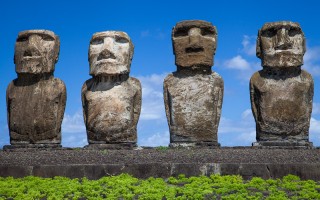 It’s official, we have a bit of an obsession with islands. When faced with the choice ‘to go’ or ‘not to go’ to a given, water locked destination, ‘GO’ always seems to win out. We’ve got loads of rationalizations about this one such as, “It’s cheaper to go now than later because we are already so close…” or, “Maybe we’ll never come back and have this opportunity again…”. Whatever it is, I can’t say I’m sorry for giving in just yet!
It’s official, we have a bit of an obsession with islands. When faced with the choice ‘to go’ or ‘not to go’ to a given, water locked destination, ‘GO’ always seems to win out. We’ve got loads of rationalizations about this one such as, “It’s cheaper to go now than later because we are already so close…” or, “Maybe we’ll never come back and have this opportunity again…”. Whatever it is, I can’t say I’m sorry for giving in just yet!
Easter Island (Isla de Pascua in Spanish or Rapa Nui in Polynesian) was the most recent detour from our loosely scheduled itinerary in South America. The pull of visiting the most remote, inhabited island in the world and exploring the culture which was responsible for the creation of the famous moai statues was too great to resist. Officially a part of Chili though the culture is distinctly Polynesian, the island forms the easternmost reaches of the Polynesian Islands. Other island borders of this region are Hawaii (7,442 km) to the north and New Zealand (7,008) to the west.
The island itself is a tiny triangular mass of land measuring approximately 15.3 miles by 7.6 miles at it’s longest and widest points respectively. The island was created by 3 major volcanoes and multiple small volcanos which have since gone extinct. The largest volcano, Terevaka, forms the highest point on the island at an altitude of 507 m (1,663 ft) and allows for a 360 degree view of the entire island and ocean beyond.
The island is notoriously expensive with food and lodging costs easily tripling the mainland prices. Many people choose to visit for no more than 4 days booking tours to each region of the island for a whirlwind of archaeology and Polynesean culture. Being on a backpacker’s budget, we figured staying a bit longer (1 week) was in order to get more from the cost of the flights themselves but also to allow us to take in the island at a more relaxed pace. The budget also meant sleeping in a tent, cooking most all of our own meals and opting for the ‘do it yourself’ approach to seeing the island over the pricy tours.
After arriving on the island, we were quickly given a tip to head over the northern beach of Anakena as a festival was underway to welcome a group of sailors which had just arrived from Tahiti. They had begun their journey from New Zealand and had navigated their way to the island using only the stars as a guide. Their journey in total was over 3.5 months in length with the last land stop in Tahiti; a spectacular 4,227 km away. They were welcomed to the island by an exchange of traditional music and dance between the two groups with the native Rapa Nui in full, traditional dress. The ceremony culminated with the placement of eyes into the beachside moai and a free feast of pork and potatoes for everyone present. All and all, a fabulous way to be welcomed to the island.
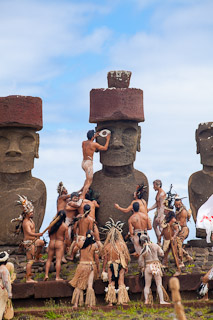 Later, we learned this voyage from New Zealand was the first of its kind covering over 5,000 nautical miles on traditional double-hulled sailing canoes traveling between Auckland, NZ and Easter Island. The group, Waka Tapu, arrived on Rapa Nui on December 5th and will retrace their voyage home making the distance sailed over 10,000 nautical miles by their journey’s end. It was incredible to have unintentionally been present to celebrate such a huge cultural and navigational milestone.
Later, we learned this voyage from New Zealand was the first of its kind covering over 5,000 nautical miles on traditional double-hulled sailing canoes traveling between Auckland, NZ and Easter Island. The group, Waka Tapu, arrived on Rapa Nui on December 5th and will retrace their voyage home making the distance sailed over 10,000 nautical miles by their journey’s end. It was incredible to have unintentionally been present to celebrate such a huge cultural and navigational milestone.
The moai are the primary attraction on Easter Island and are as impressive as one can imagine. The entire island is one huge archaeological site and wandering the coastline brings you into close contact with countless sacred sites. The majority of archaeological sites on the island exist in a natural state of disrepair. Many of the moai statues were apparently pushed forward onto their faces and broken, presumed by waring factions in the island’s past, but the features of the statues are amazingly intact making it easy to imagine how impressive they must have been in their day.
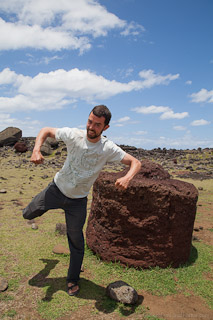 There are five restored archaeological sites on the island in which the statues were re-erected and repaired upon their original sacred platforms or ahu. In total, there are nearly 900 statues accounted for on the island, around 50 of which have been re-erected onto their original ceremonial platforms with more than 390 statues present in their birthing ground of Rano Raraku where they have remained unaltered for centuries. The remainder of moai are scattered across the island, the majority of which are located along the coastline where they were meant to protect the Rapa Nui people from the spirit world in the sea. Most impressive of these sites was Rano Raraku because the statues were present as they were when the practice of ancestor worship was in its prime.
There are five restored archaeological sites on the island in which the statues were re-erected and repaired upon their original sacred platforms or ahu. In total, there are nearly 900 statues accounted for on the island, around 50 of which have been re-erected onto their original ceremonial platforms with more than 390 statues present in their birthing ground of Rano Raraku where they have remained unaltered for centuries. The remainder of moai are scattered across the island, the majority of which are located along the coastline where they were meant to protect the Rapa Nui people from the spirit world in the sea. Most impressive of these sites was Rano Raraku because the statues were present as they were when the practice of ancestor worship was in its prime.
During our week on Rapa Nui, we visited each of the moai sites scattered across the island, saw sunrise and sunset at some of the most uniquely beautiful historic sites in the world, found secluded tidal pools to explore, climbed to the highest point on the island (Terevaka), visited a spectacular volcanic crater lagoon (Orongo) and witnessed the ‘birthing’ place of the great moai statues (Rano Raraku). We also met other like minded travelers, shared a meal of the most fabulous sashimi I’ve ever tasted prepared by a elderly Japanese man staying at our campground and went to sleep every night listening to the waves crashing upon the rocky shore. The island in short, was magical. Though not a traditional backpacker’s destination, we found it was certainly possible to accomplish on a small budget.
You can see a gallery from our week long visit to Easter Island here.

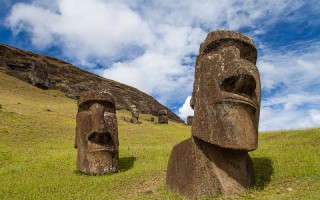
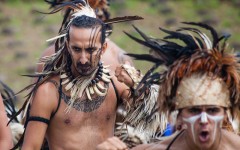
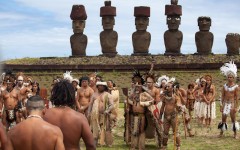
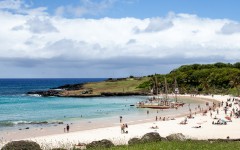
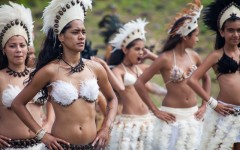
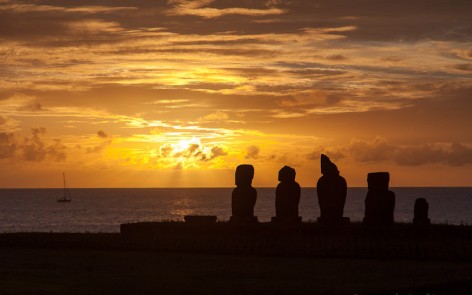
Your blog just gets better and better. The photos are impressive….I can’t imagine how awesome actually being there is. Thanks for sharing your amazing travels. Happy Holidays and hope you get to feeling better Kenny.
Mick, you are too kind. We are way behind on posts, pictures, etc., but being sick gave us a chance to catch up a little. Thanks for the well wishes… we will scout for antibiotics in the morning to try and kick it in the butt. I hope your family has a fantastic holiday season with the ability to work as little as humanly possible.
Laura & Kenny
Merry Christmas! Amazing! This adventure sounds like it is going great! Keep posting, we love it and hope you are feeling better!
and hope you are feeling better!
Colette and Payton
Merry Christmas and Happy New Year to you and Payton!!! Finally starting to kick the colds. Hopefully we’ll be back up and running full steam ahead soon.
That is so awesome. You must be in amazement 90% of the time. I’ve seen shows on Easter Island. They practiced cannibalism at one point in time so you may want to make sure you are staying around “well fed” locals. Hahaha. Have a great time!
Marshall
Yeah, we pinch ourselves quite regularly.
We learned cannibalism on the island came about due to their food supply running out, which was largely due to heavy deforestation of the island. However, there is evidence of cannibalism on other Polynesian islands at a time when food was plentiful, so I guess a lack of food isn’t the only reason for turning to “the other white meat”. 😉
This looks so amazing! It seems to be as impressive as Galapagos even though in another way. I definitely have to put that on my travel plans when I’m going back to Argentina/Chile. Enjoy and take care!
Anita, it definitely is a worthwhile place to see! It is completely different from the Galapagos though it was hard not to compare the two since we saw both so close together. One has tons of wildlife, the other has tons of culture.